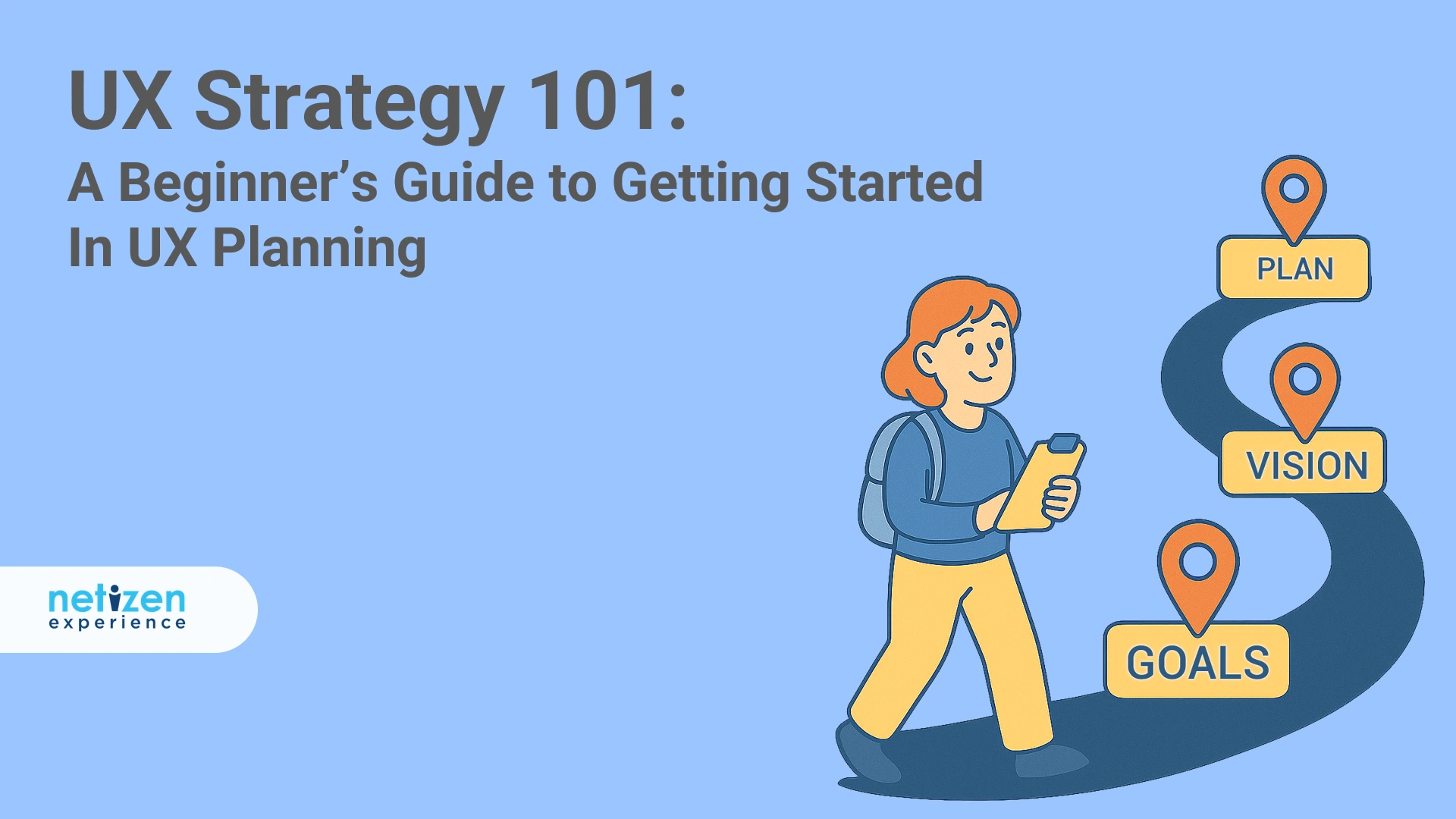Imagine this: your team is halfway through building a product. Features keep getting added, deadlines shift, and suddenly users are confused about what your app actually does. You’re scrambling to patch usability issues, chasing feedback, and trying to keep stakeholders happy.What you really need isn’t more quick fixes — it’s a UX strategy.A UX strategy gives direction before things spiral out of control. It connects user needs to business goals, aligns your team on priorities, and helps you design with intention instead of guesswork. For new UX professionals, it’s the difference between designing in survival mode and shaping experiences that grow with the product.In this guide, we’ll cover what a UX strategy is, who creates it, when to use it, and how to build one.[ez-toc]
Basics of UX strategy?
What Is UX Strategy?
At its core, a UX strategy is simply a plan for how user experience will be shaped and improved over time. Think of it as a guide that helps teams stay aligned on the direction they’re heading and the priorities along the way. A strategy can cover an entire product, a single service, or even just one feature, but the goal is always the same: to make sure design choices contribute to both a better user experience and stronger business outcomes.A key part of this is the UX roadmap, which lays out what’s coming up and when, so everyone knows how today’s design decisions connect to tomorrow’s goals.
Who Creates It?
Most of the time, a UX strategist or UX lead puts the strategy together. They pull from research, design insights, and business goals to chart the path forward.But even if you’re a designer or researcher, understanding UX strategy is valuable. It gives you better context for why certain decisions are made, and if you eventually step into a leadership role, the concept won’t feel so foreign.
Who’s Involved And Impacted By UX Strategy?
Although the strategist or lead creates the plan, it isn’t done in a vacuum. Input usually comes from:
- Designers and researchers, who contribute user insights.
- Product managers, who tie user needs to business goals.
- Developers, who flag what’s technically realistic.
- Stakeholders, who care about the bigger business vision.
The outcome impacts everyone — from the product team working on features to the business side tracking results.
What Is A UX Roadmap?
If the strategy is the “why” and “what,” the roadmap is the “when.” It’s a visual plan — sometimes a simple spreadsheet, sometimes a more polished deck — that outlines upcoming work, timelines, and themes.The roadmap helps:
- Keep the team focused on the right problems.
- Show how short-term tasks link to long-term vision.
- Provide a single reference point everyone can align on.
Whether you’re a researcher, designer, or stakeholder, the roadmap makes it easier to see not just what’s happening, but also why it matters.

Why Is UX Strategy Important?
A UX strategy isn’t just paperwork—it’s what keeps teams aligned when the pressure is on. Imagine a food delivery app rolling out new payment options. Without a clear UX strategy, designers might focus on flashy interfaces, developers on speed, and business teams on maximizing transactions. Each effort makes sense on its own, but together they risk creating a clunky or confusing experience.With a UX strategy in place, everyone is working from the same playbook. It connects business goals with user needs—whether that’s fewer abandoned checkouts, smoother sign-ups, or more trust in sensitive actions like payments. In practice, this means less guesswork, fewer misaligned priorities, and a product that feels consistent at every touchpoint.
Key Ingredients of UX Strategy
Think of a UX strategy like building a house. You can’t just jump straight into decorating; you need a solid foundation, strong pillars to hold everything up, and then the finishing touches that make it practical and livable. The same goes for UX strategy: it starts with the core elements, is supported by the right pillars, and works best when you keep a few practical reminders in mind.
1. Core Elements (the foundation)
Every sturdy house begins with a foundation, and in UX strategy that foundation is made up of three things:
- Clear goals – Goals connect user needs with business priorities. Without them, you risk building something impressive-looking but ultimately irrelevant.
- A vision – This is the “why” behind your UX work, the statement that keeps everyone aligned on what value you’re delivering and how you want users to experience it.
- A plan – Just like a blueprint, a plan breaks down lofty goals into specific actions and objectives. It gives your team a roadmap to track progress and stay focused.
Without these elements, the strategy is just an idea—solid in theory but shaky in execution.
2. Supporting Pillars (what keeps it steady)
Once the foundation is set, a house needs pillars to stand tall. In UX strategy, these pillars give stability and ensure the strategy doesn’t collapse under real-world pressures:
- Validated user research – Ground every decision in feedback from real users. Instead of guessing what people want, talk to them. Observing how real users interact with your product or running usability tests often uncovers issues no one on the team spotted.
- Business strategy – A UX strategy doesn’t exist in a bubble. It needs to support how the business makes money, positions itself in the market, and measures success. Keep company objectives, market position, and revenue goals in sight.
- Value innovation – This is about finding smarter ways to solve problems—delivering something new or different that actually matters to users, while still being efficient for the business. Differentiate in ways that matter, without adding unnecessary complexity or cost.
- User experience design – Finally, this is where all the plans take shape. The design is what users see, touch, and feel. Strong design brings together the insights from research, the priorities from the business, and the opportunities for innovation into something practical and usable.
When these pillars are strong, they balance the needs of users, business, and innovation.
3. Practical Reminders (the finishing touches)
A house isn’t complete without the small but important details that make it livable. Similarly, UX strategies benefit from practical reminders that keep things grounded:
- Stay user-centered – It’s tempting to prioritise internal targets, but at the end of the day, users decide whether your product succeeds. Keeping them at the center ensures you’re solving real problems.
- Be specific – Vague goals like “improve engagement” don’t guide teams. Specific targets like “increase mobile sign-ups by 25%” do.
- Prioritise speed and accessibility – Users judge quickly. A slow or inaccessible experience can ruin everything else.
- Involve decision-makers – UX doesn’t happen in isolation. Keep stakeholders engaged from the start. Getting leadership involved early helps align priorities and avoids rework later.
- Take a holistic view – UX isn’t just what’s on-screen. Think about the full journey: how people first discover your brand, the support they get after purchase, and everything in between. Each touchpoint shapes the overall experience.
These reminders may seem small, but together they’re what turn a good strategy into one that truly lasts.
UX Strategy Examples
Let’s bring it to life with an example.Imagine an online language learning service. The team’s vision is simple: make it easy for learners to connect with the right tutor. From there, the goals start to take shape:
- User goal: give learners better access to tutors who match their needs.
- Business goal: grow paid memberships.
- Key result: a 30% increase in sign-ups within the next six months.
The UX strategy to support this vision could include things like:
- Reviewing how tutors and students are currently paired
- Running competitor research to see how others handle matching
- Interviewing users to spot gaps
- Tightening the tutor vetting process
Each of these steps ties back to both the learner’s experience and the business’s growth.Now, let’s look at another scenario.Picture a mid-sized e-commerce brand that sells eco-friendly home goods. Their vision might be: make sustainable shopping effortless. The goals could look like this:
- User goal: help customers quickly find products that fit their values (e.g., plastic-free, locally made).
- Business goal: increase repeat purchases.
- Key result: a 20% boost in returning customer sales over the next year.
The UX strategy here might involve:
- Improving the product filter system
- Adding clear eco-labels
- Simplifying the checkout
- Testing different loyalty program designs with users
Again, notice how each decision balances user needs (shopping with confidence) and business outcomes (repeat sales).[caption id="attachment_7889" align="aligncenter" width="640"]

Photo by Christina Morillo from Pexels[/caption]
Final Notes
UX strategy isn’t just for big corporations or long-term planners — it’s what helps any team avoid getting lost in last-minute fixes and endless feature requests. With a solid strategy, you’re not just reacting to problems as they pop up; you’re guiding your product with purpose, balancing what users need with what the business wants to achieve.Whether you’re mapping out a language learning service or making eco-friendly shopping smoother, the core ingredients are the same: clear goals, a shared vision, and a practical plan that everyone can follow. Add the right pillars and keep the reminders in mind, and you’ll have a strategy that not only steadies your product today but also scales with it tomorrow.In short: a UX strategy helps you move from building features to building experiences that last.Need help to create a comprehensive UX strategy for your upcoming project? Contact us to initiate a discussion.





